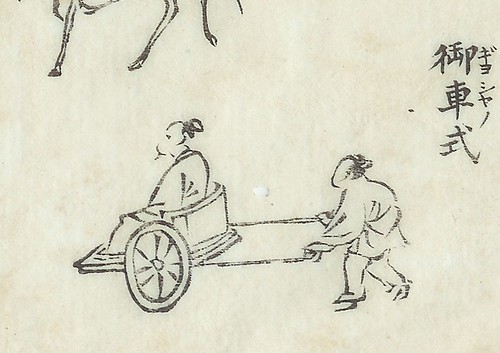Here is a bit of a puzzle for our readers to clear up. A while back I pointed at a nice collection of 17th Century Dutch pictures of Japan. Jonathan Dresner was rather surprised by this one

What is this? It’s not a rickshaw, since it’s backwards and too early. An update at BibliOdyssey pointed me to a version of this from a site in Kyoto that gives the English title of the plate as Mandocorosama’s Maid of Honor, carry’d in little two-Wheel’d Chariots. Not much help, although it does seem to connect the cart to the elite. Fortunately, I came across some evidence while doing research recently. Specifically, I was headed into the kitchen to do a bit of research on the state of the leftovers in the fridge and I saw this hanging on the wall…

What’s that in the lower left?

This is from a Meiji-era Japanese book I bought on E-Bay entitled “A New Guide to Chinese Painting” and I’m guessing it was intended for Japanese who wanted to be able to paint scenes of China.1 So what is this vehicle? If we assume that the top character is 御 things get a little clearer. Gyo in Japanese or ya in Chinese means of or pertaining to the emperor, although it can also mean to govern (or drive) a cart according to Nelson. Neither Nelson nor 漢語大詞典 have a specific entry for 御車, although they have lots of things like 御手﹐and 御衣 which makes me think it is -not- an “imperial carriage” although I suppose it could be. It does seem to be something that the Japanese associate with China, however, so maybe it was reserved for the elite. Anyone have any ideas?
I’m pretty sure it is actually an authentic Meiji book, since it has the silverfish holes that are hard to fake and the nice thin paper. Plus it was only 10 bucks, so if anyone put work into faking it they are sure letting it go cheap. ↩
The characters are definitely 御車式. 御車 was indeed in use during the Meiji period to mean “the Emperor’s carriage” and was eventually applied to trains and automobiles as well. But I strongly doubt that this has anything to do with this, simply because that picture is so simple (an Emperor who sits out in the open on a wheeled seat, with an entourage/crew of one dude? no way).
Given that the other captions on the page say things like 騎馬式 (“the fashion in which one rides a horse”), 負手式 (“the fashion in which one holds one’s arms behind one’s back”), and 両人對坐式 (“the fashion in which two people sit facing each other”), it seems likely that the 御 in 御車式 is also supposed to be a verb, the one you mention from the Nelson, with the whole thing meaning just “the fashion in which one drives a carriage.” Which brings us no closer to the question of whether this kind of carriage had a special name (in fact it suggests that it doesn’t–this author seems to be implying that a 車 in China would look like this, period).
(I can’t help but wonder if the very reason it’s in the book is because it was as unusual for Meiji folk to see a “carriage” pushed from behind as it is for us today!)
This first reminds me of 御茶, the pattern of which is very similar to that of 御車. It is pronounced as おちゃ and simply refers to tea. But it does not sound right here since it is pronounced differently in the above image.
Then I looked up the 御 at an online Chinese dictionary (http://xh.5156edu.com/html3/4644.html.The) 御 can be used as a verb, which means to drive a carriage. I also find a Chinese phrase referring to “the Emperor’s carriage,” which is 御驾.
The illustration is originally from the famous Ming dynasty manual of painting for aspiring literati painters, the Mustard Seed Garden manual of painting (芥子園畫傳). Wikipedia gives an nice overview of its place squarely in the mainstream of Jiangnan literati culture (http://en.wikipedia.org/wiki/Jieziyuan_Huazhuan)
The rest of the chapter it comes from has various pictures of peasants and literati in rustic settings to be used in composing landscape scenes, so the imperial sense of 御 is unlikely to be used here.
It’s a wheelbarrow, very common form of transportation in China prior to mechanization. Needham has a long discussion in whatever volume deals with the wheelbarrow, I’ve forgotten. But I recall a very cool photo of a man pushing two women around on a wheelbarrow with a gigantic center wheel.
Michael Turton
No Chinese references I can find. It’s not the Hanyu Da Cidian, for instance. I did find an ornamental tree connected with the term 御車返し, however:
http://www.shuttermoments.ca/articles/sakura/cherryguide.htm
With the gardening theme of the Japanese work, perhaps it’s connected (long shot).
On the other hand, I could see how a carriage that puts the porter out of sight would be considered good for flower viewing. Also it would be quite unacceptable to have a member of the imperial family look at some peasant’s behind carrying him around, as in the more typical rickshaw design of later days. They were carried in palanquins, of course, but that would tend to cut down your view of the surroundings, so the 御車 may simply be a form of carriage in imitation of the royal model that allows for better sight-seeing.
For all it’s worth. D.E. Mungello in “Curious Land” (1989, p. 242, plate 15) reproduces the front page of 小儿论 (“Dialogue [of Confucius] with a child”), published in 1680. where Confucius is shown carted around by a servant in a very similar wheelbarrow-like wheeled chair. (And, indeed, 御車 is mentioned in the first line – that is, column – of the text) So probably this kind of conveyance was quite common at the time in China as well as in Japan.